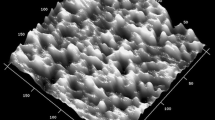Abstract
The oxidation behavior of an Fe-35Ni-18Cr-2Si alloy commonly used as a resistance heating-element material has been studied in the temperature range 1000–1300°C. Techniques employed included thermogravimetry at constant temperatures, measurements of chemical changes in the protective oxide film, and metallography. The oxidation behavior was found to approximate a parabolic law and data obtained gave an estimate of the activation energy for oxidation of 125 kJ/mole (30 kcal/mole) at around 1000°C and 339 kJ/mole (80 kcal/mole) at higher temperatures. The concentration of elements in the protective oxide was found to be both temperature and time dependent. Chromium became concentrated at the expense of nickel and iron at the lower temperature (<1100°C) and was found to evaporate out of the oxide at higher temperatures and longer times, thereby increasing both the nickel and iron concentrations. On the basis of changes in the chemical composition of the oxide film, together with scaling, the method of failure of heating-element wire by the development of hot spots can be explained. At failure both long-term (low temperature ⩽ 1000°C) and shorter term tests (temperature > 1000° C) were found to have oxidized to the same depth. This can be explained on the basis of a depletion of chromium having occurred at the oxide-alloy interface, and that on scaling, insufficient chromium was present to reform a protective film.
Similar content being viewed by others
References
C. S. Giggins and F. S. Petit,Trans. Met. Soc. A.I.M.E. 245, 2495 (1969).
E. B. Evans,Corrosion 21(8), 274 (1965).
E. A. Gulbransen and K. F. Andrew,J. Electrochem. Soc. 106(11), 241 (1959).
M. G. Hobby and G. C. Wood,Oxid. Met. 1(1), 23 (1969).
T. Ericsson,Oxid. Met. 2(4), 401 (1970).
F. E. Bash and J. W. Harsch,Proc. Am. Soc. Test. Mater. 29(II), 506 (1929).
R. Stevens, E.C.R.C., R/985, 1976.
D. P. Whittle,Corros. Sci. 12, 869 (1972).
I. Zaplatynsky,Oxid. Met. 11(6), 289 (1977).
W. C. Hagel,Trans. Am. Soc. Met. 56, 583 (1963).
J. M. Francis, C. J. Lee, and J. H. Buddery,J. Iron Steel Inst. September,206(9), 921 (1968).
M. G. Hobby and G. C. Wood,J. Iron and Steel Inst. January,203(1), 54 (1965).
J. M. Francis, M. T. Curtis, and D. A. Hilton,J. Nucl. Mater. 41, 203 (1971).
R. Stevens, unpublished work.
G. C. Wood,Oxid. Met. 2(1), 11 (1970).
D. Caplan and M. Cohen,Corros. Sci. 7, 725 (1967).
S. Ali and G. C. Wood,J. Inst. Met. 97, 6 (1969).
J. M. Francis, M. T. Curtis, and D. A. Milton,J. Nucl Mater. 41, 203 (1971).
D. P. Whittle,Corros. Sci. 12, 869 (1972).
Author information
Authors and Affiliations
Rights and permissions
About this article
Cite this article
Stevens, R. Failure and oxidation phenomena in Fe-35Ni-18Cr-2Si heating-element wire. Oxid Met 13, 353–379 (1979). https://doi.org/10.1007/BF00609305
Received:
Issue Date:
DOI: https://doi.org/10.1007/BF00609305




